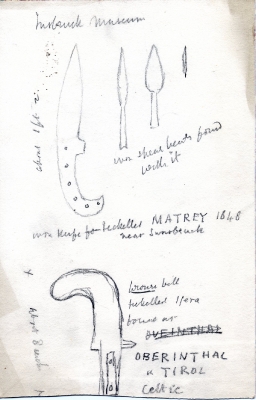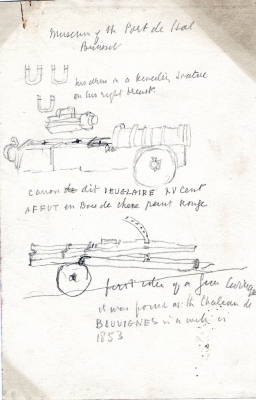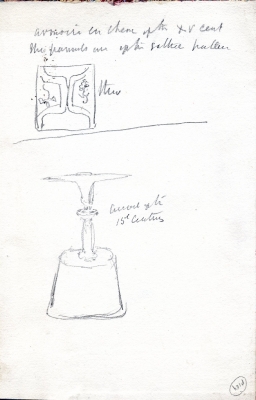Influences upon Pitt-Rivers' artistic interests
Introduction
It is clear that Pitt-Rivers had formed opinions about art, accuracy of depiction, and taste by the time he inherited his estate (including a large art collection) from Lord Rivers in 1880. This page seeks to explore some of the influences that formed these opinions. See here for an article which discusses Pitt-Rivers' drawing game in which he investigated the apparent degeneration of art.
Art and Archaeologists
Levine argues that the 'idea of archaeology as fundamentally connected to artistic values was widely held' in the nineteenth century. Churchill Babington in 1865 defined as archaeologist as requiring the following qualities:
Like the naturalist, the antiquary must in the first place bring together a large number of facts and objects ... In a certain sense every archaeologist must be a collector: he must be mentally in possession of a mass of facts and objects ... but he must also, when there are sufficient data, proceed to reason upon them. He puts them together and considers what story they have to render up ... He must be a man of learning ... Another thing very desirable ... is an appreciation of art. [Babington, 1865:63-6]
Samuel Birch, in his 1867 paper, 'Inaugural discourse delivered in the section of General Antiquities ...' concluded that the value of archaeology was that it aided 'the formation and cultivation of public taste by directing it to the selection of the good and the useful'. [all quoted in Levine, 1986: 90-1]
So Pitt-Rivers might always have been engaged in an appreciation of aesthetics by the very fact of his being involved in archaeology and antiquarianism. However, it is clear that an overt and public appreciation of aesthetics from him is much more apparent after 1880 than it was beforehand.
Pitt-Rivers' views on art
On 4 November 1888 Tylor wrote to Pitt-Rivers to thank him for sending a copy of Collier's Art Primer, Tylor remarks that he is glad that Collier was 'breaking ground in a rational theory of Art very different from what used to prevail'. [L573, Salisbury and South Wiltshire Museum].
Pitt-Rivers cites Collier's Primer on Art (actually, John Maler Collier, 'A primer of Art' published in 1882) here. As this is the only reference work cited in his only public address to concern itself with matters of art one must presume it was influential upon him (though it is mentioned because it uses examples from his collections to illustrate the text). The book is listed in the catalogue of Pitt-Rivers' library, he had the 1882 edition published by Macmillan and bound in green cloth. A copy of part of this book is available from googlebooks here.
On page 5-10, Collier says:
'The ethnographical collection of General Pitt-Rivers, F.R.S., which has been for some time on view at South Kensington, gives many interesting examples of the development of ornament. Amongst others there is a series of paddles which give a number of intermediate steps between a well-defined human face, and a mere conventional ornament like a crescent into which the face eventually grows (Fig 3, this figure is shown here from its original outing as Plate IV of Pitt-Rivers 'Evolution of Culture'). A similar process of what may be called degradation is exemplified in a work by Mr John Evans, F.R.S., on the coins of the ancient Britons. ... Any natural object could give the starting point for a pattern which would soon lose all resemblance to the thing it originally represented, and of which the changes would be merely controlled by that mysterious law of harmony which probably has its origin in association of pleasing ideas, and partly perhaps in the actual structure of the eye, but which is too little understood to be more than alluded to here. The well-known Greek fret, variations of which are spread over the whole inhabited earth, has been traced back by General Pitt-Rivers to a double loop, a form assumed by the tendrils of many plants, or which might accidentally occur in any piece of fibre or sinew used by man (Figs 5 and 6). It is, however, curious to remark that there is some evidence of this pattern having been developed by the Peruvians from the representation of a human face, and, indeed, in a process of simplification, like the one we are considering, there is no reason to doubt that the same pattern might be arrived at independently by different tribes and even from different sources. The origin of decorative art is therefore to be found in the imitation of nature, and it is probable that all ornaments, no matter how conventionalised, could, with adequate knowledge, be traced back by a series of minute modification to some natural object.'
Other influences
It seems likely that his views were based upon outside influences as well as his own artistic tastes. In this section I show some of the things that might have influenced him. He could have read all these sources (the circumstances that lead to this conclusion are given for each source) and as sources they presumably reflect contemporary thought in these areas. In some cases lengthy extracts are transcribed from the sources in separate webpages.
1. W.H. Wesley: 'XII On the iconography of the skull', Memoirs read before the Anthropological Society of London 1865-6 Vol II, London 1866 page 189 et seq. See here for extract
It is easy to see how this paper might have influenced Pitt-Rivers as Wesley's comments on drawing skull accurately are also completely applicable to drawing artefacts into catalogues as Pitt-Rivers caused to be done.
2. Art-related books in Pitt-Rivers library
The following references have been checked against the catalogue of the Bodleian Library and may differ slightly from the sometimes slightly inaccurate catalogue. Apart from Collier listed above, these are:
Adeline, Jules. 1884 Lexique des termes d'Art Paris: Maison Quantin
Balfour, Henry 1893 The Evolution of Decorative Art London, Rivington, Percival & Co.
1874 The Pictorial Gallery of Arts London: Cox [this cannot be identified]
Crowe, Joseph Archer and Giovanni Battista Cavalcaselli 1871 A History of Painting in North Italy ... from the 14th to the 16th century London: J. Murray
Crowe, Joseph Archer and Giovanni Battista Cavalcaselli 1879 Lives of the Early Flemish Painters ... [third edition] London: J. Murray
Crowe, Joseph Archer 1874 A Handbook of painting, The German, Flemish and Dutch Schools ... London: J. Murray
Eastlake, Charles Lock Materials for a history of Oil-painting Longman London 1847
Eastlake, Charles Lock 1847-1869 Contributions to the Literature of the Fine Arts Murray London: Longman
Elmes, James 1824 A General and Biographical Dictionary of the Fine Arts Chiswick
Fairholt, Frederick William n.d. A dictionary of terms in Art London: Strahan & co.
Gerspach, Edouard 1885 L'Art de la Verrerie Paris: Quantin
Girton, Thomas Exhibition of the Works of Burlington Fine Arts Club Spottiswood London 1875 [NB there are quite a few catalogues of various exhibitions held at the Club too]
Gonse, Louis 1883 L'Art Japonais Paris: A. Quantin
Havard, Henry ?1881 Histoire de la peinture Hollandaise Paris: A. Quantin
1747 Sculptura historico-technica or History and Art of ingraving London printed for S. Harding 1847
Lanzi, Luigi 1828 The History of Painting in Italy ... translated from Italian by T. Roscoe London: printed for Simpkin
Lowth, G.T. A Notice on the Rise and Decline of Art 1893 [this cannot be identified]
Malcolm, James Peller 1813 An Historical sketch of the art of Caricaturing London: Longman
Maskell, Alfred 1884 Russian Art and Art Objects in Russia ... in the South Kensington Museum London: Chapman and Hall
Scharf, George 1865 Catalogue of the Pictures belonging to the Society of Antiquaries Bungay
Scharf, George 1876 Notes on the principal portraits of Mary I of England and Mary Queen of Scots London: J. Murray
Solon, Louis Marc 1885 The Art of the Old English Pottery London: Bemrose & Sons
Wauters, Alphonse Guillaume Les peintures Flamande Paris: Quantin n.d.
Woltmann and Woermann 1880 History of Painting, vol 1 Ancient Early Christian and Medieval Painting London: Kegan Paul & Co
Pitt-Rivers' artistic endeavours
Although Pitt-Rivers is known to have thought that artistic skill was important to an observer and thinker about material culture, it is not clear whether he himself had any artistic talent. The illustrations here shows drawings he made whilst visiting European museums, held in Salisbury and South Wiltshire Museum Pitt-Rivers papers.
Drawing was one of the things that members of his class were routinely taught when they were growing up and Pitt-Rivers was also taught how to survey (something he found very useful in his archaeological investigations). Members of his family had some drawing facility (he discusses their artistic abilities here). However, we know that he both employed and supervised expert draughtsmen (or at least judged their accuracy in depiction). He must therefore at least have had views on accuracy if not on broader artistic merit.
Pitt-Rivers certainly did draw though. One of his first publications shows this:
'I may here acknowledge the great obligation I am under to Mr. Franks for the facilities he has afforded me in drawing many of these specimens in the Christy Collection' [Primitive Warfare II, 1868]
Bibliography for this article
Babington, C. 1865 An Introductory Lecture on Archaeology delivered before the University of Cambridge Cambridge
Birch, S. 'Inaugural discourse delivered in the section of General Antiquities at the Annual Meeting of the Archaeological Institute in London. July 1866' Archaeological Journal XXIV (1867) pp. 1-12
Levine, Philippa 1986. 'The Amateur and the Professional: Antiquarians, Historians and Archaeologists in Victorian England 1838-1886' Cambridge: Cambridge University Press
AP, September 2010, revised May, June 2011, copies of Pitt-Rivers' drawings added August 2011, updated with items from PR's library October 2011
[All extracts transcribed (and edited for length) by Alison for the Rethinking Pitt-Rivers project]





